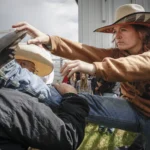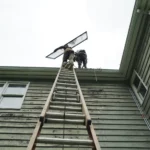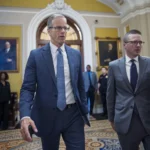FRIDAY FOCUS: Wyoming’s State Health Officer on COVID-19 and Pandemic Preparedness (Part 1)
Ahead of the three-year anniversary of the pandemic’s onset, Dr. Alexia Harrist reflects on what worked and what didn’t in Wyoming’s COVID-19 response
- Published In: Other News & Features
- Last Updated: Mar 10, 2023

By Jacob Gardenswartz
Special to the Wyoming Truth
On March 11, 2020, the Wyoming Department of Health announced the state’s first lab-confirmed case of “coronavirus disease 2019,” long before anyone knew how devastating the COVID-19 pandemic would turn out to be.
Three years, 185,000 infections and over 2,000 deaths later, the Wyoming Truth spoke with state health officer Dr. Alexia Harrist about how Wyoming fared throughout the pandemic — what worked, what didn’t and what lessons can be gleaned for the future.
Harrist, a graduate of Yale University, the Perelman School of Medicine at the University of Pennsylvania and the Boston Combined Residency Program in Pediatrics, worked as a Centers for Disease Control and Prevention Epidemic Intelligence Service Officer assigned to Wyoming when the Ebola and Zika viruses were of key concern. In 2017, she joined the Wyoming Department of Health as the state epidemiologist and soon became state health officer.

Harrist worked alongside local, state and federal leaders to coordinate Wyoming’s COVID-19 response, as well as manage other matters pertaining to infectious diseases and vaccination programs.
What follows are excerpts from part one of the interview. Check back on Saturday for part two.
What sparked your interest in the work of public health, and how did you end up in this position?
Harrist: I’m a pediatrician by background. I did a pediatric residency and then worked for a little while in an urgent care setting, in an emergency room but seeing the less acute patients. In my time after residency, I became very interested in how we can prevent people from needing to go to the hospitals in the first place and especially ending up in the emergency room — kids in particular. That was what really got me interested in public health . . . .
Saturday marks three years since the first COVID case was announced in the state. With hindsight being 20/20, how do you think Wyoming fared throughout the pandemic?
Harrist: . . . we know a lot more now than we did three years ago. If we were in the same position now as we were in March of 2020, then we weren’t doing our jobs — learning about the virus and developing better and better tools to fight the virus.
But I think a lot of things we did, looking back on it, I’m very proud of and I think worked quite well. First, bringing up testing and the work our Wyoming Public Health Laboratory did, ramping up testing very fast when there weren’t really other testing options available to ensure that Wyoming residents could get tested if they were sick. . . . The volume of testing our lab did for COVID, it’s really just incomparable to the volume of testing we did before that… As the pandemic grew, we recognized there were additional testing needs, so we made at-home testing available for anyone in Wyoming community testing sites. We were able to provide testing for healthcare providers and long-term care facilities and schools.
Secondly, [through] our epidemiologic work, we conducted thorough contact tracing for far longer than most states… And I really think that that helped us avoid an early surge, at a time where we didn’t have as many tools as we were able to have later, in particular in terms of testing and treatments. And we developed systems similar to the lab — the volumes of data we were handling related to COVID were much higher than we were handling at a normal level. . . . .
I’d like to point out schools. You know, we had schools open since June of 2020 and never closed them again. We, of course, had precautions in place to make sure our students had the opportunity to continue in-person learning, but still being safe. And we never had to close a school due to a COVID outbreak after they were opened in June of 2020. I really think that prioritizing education and the experience of our students was certainly one of the things I was proud of.
Distribution of vaccines and therapeutics, also not normally activities that the Wyoming Department of Health does at a large scale — the ability to develop new systems to rapidly make those vaccines and therapeutics available and accessible to people was definitely something that worked. And most of these things were only possible because of our local public health representatives and local public health officials who were really the boots on the ground… The work they did was just absolutely incredible. And then I’ll just point out — this is obviously a national thing — but having vaccines as soon as we did that continue to be effective at preventing severe illness and death available within a year of the emergence of a new virus was just a great success for our country.
Just over half —about 52% — of Wyomingites are fully vaccinated. That’s not even including boosters. And that’s the lowest proportion of any state in the country. Why do you think that is? Is it a problem Wyoming should address?
Harrist: There’s certainly no doubt we wish more people had taken [the] opportunity to be vaccinated and continue to hope people take the opportunity to get vaccinated if they haven’t, and to continue to stay up-to-date on booster doses. Our role was to try to make vaccines as available and accessible as possible, reduce as many barriers as we could to getting those vaccines. And I think we did that… In the future, we will continue to play that role as long as the vaccines are coming through the federal government . . . and to provide evidence-based scientific information to people and to providers to help them make that decision.
There have been discussions nationally and in states throughout the country about whether governments should mandate vaccination. Would you support COVID-19 vaccination requirements to access certain public services?
Harrist: Mandating COVID vaccines is not something the Wyoming Department of Health did. . . . The required vaccinations we have for schools and childcare centers, those do not include COVID. I do think those [requirements] were really essential in getting us up to the vaccination levels we have for diseases like measles and polio. And so I think those school and child care requirements are very important. But we have no plans at this point to include COVID in those required vaccines.
Why not institute COVID-19 vaccine requirements in schools if you have that authority and requirements have increased vaccine uptake for other diseases?
Harrist: I think, for those other vaccines, we have defined schedules. . . . The COVID virus is changing, the vaccine schedules are changing, and all of those things we’ll keep watching over the next several years. We don’t even have a defined schedule for COVID vaccines yet.













